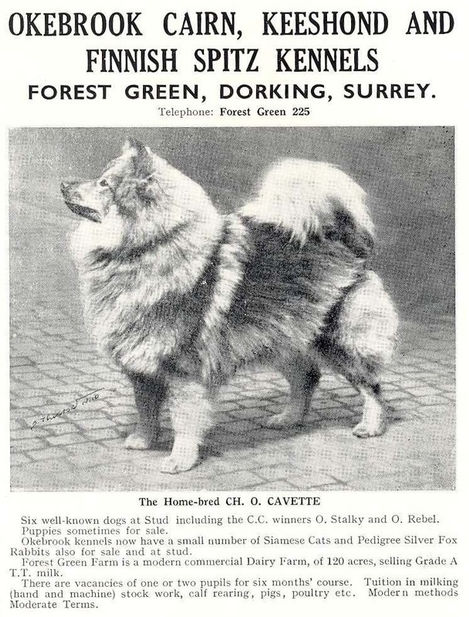1940's; Post War
During World War II, like many other breeds, the Keeshond faced challenges due to the widespread disruption and upheaval. The war period was particularly tough for dog enthusiasts and breeders, as resources were scarce, and many activities were curtailed.
After World War II, very few Keeshonds remained. Many kennels had to distribute their dogs among friends and relatives due to the scarcity of resources. While it was often possible to find enough food for one dog, feeding multiple dogs was challenging under wartime rationing. Additionally, many of the remaining dogs were older.
During the war, no championship shows were held because people were preoccupied with wartime duties, and travel was difficult due to fuel shortages and nighttime driving restrictions. Although small local shows were organized as a form of relief, these events were not widely attended. Margo Emerson’s book “Keeshonds of the World” recounts a humorous story about Mrs. Newbold, who initially sought a Chow but ended up with a Keeshond. Despite this mix-up, a neighbor encouraged her to show the dog. After unconventional grooming, which included pulling out the undercoat and clipping, the Keeshond surprisingly won four awards due to the low competition. This experience led Mrs. Newbold to acquire Queen of Tufton, whose offspring included Major of Broadcliffe, the first post-war Keeshond champion. Major was a well-balanced dog with great character, siring three champions in one litter, including Verschancing of Vorden, the father of Volkrijk of Vorden, who won Best in Show at Crufts in 1957. The initial show dog, Hendrick of Ravensknowle, had managed to win over four hundred awards during the war, mostly firsts.
Miss Barbara Glover successfully preserved five members of the Evenlode line—Lucinda, Liebling, Lehrmeister, Pieter, and Penelope—on behalf of Miss Hastings, who had served in the First Aid Nursing Yeomanry during the war. Miss Glover used a pup from Pieter and Penelope, named Truda of Evenlode, to start her own breeding program under the Welford affix. Tabitha from the same litter went to Margo Emerson and became the foundation of the Rhinevale line.
Mrs. Wingfield Digby managed to place her dogs with castle staff and relatives, allowing her to regroup with dogs like Landfall and Fingal. She still had older dogs such as Brother of Blackie and Fimon. By 1946, the family remained at Raleigh Lodge, which they had moved to during the war to allow the castle to be used by the military. The kennels at the castle needed repairs before the dogs and family could return. During the war, the Keeshond fur was spun into garments for troops, with Mrs. Wingfield Digby’s dogs' fur being used exclusively for Home Guard mittens, a force commanded by her husband in Dorset.
Doreen Anderson of Kultz played a crucial role in keeping the Keeshond Club active, even if just nominally, with Baroness Burton and Mrs. Wingfield Digby covering the annual registration fees and maintaining the paperwork.
A few kennels managed to continue through the war with one or two dogs, including Muirville, where Havoc of Muirville had previously received positive reviews at pre-war shows. In 1944, Muirville produced two pups, Hals and Hedy of Muirville. The Summerleaze kennels, based on Florinda van Zaandam, also persevered.
As the decade ended, one of the breed’s most famous dogs was born. His sire, an abandoned puppy found in Austria during the war, was rescued by Mrs. Wingfield Digby at age two. Recognizing his potential, she bred him with her Benita van Zaandam, registering him as Bimbo of Puch. The result was the dog that became Int. Ch. Billo van Zaandam. A second litter from Bimbo and Benita produced Bobrie, and these two, along with Birlinn, a grandson of Bimbo and Benita, were Mrs. Digby’s cherished pets through the 1950s and 1960s.
As the war ended and the 1940s progressed, the Keeshond began to emerge from the shadows of wartime constraints. The post-war era saw a revival of interest in dog breeds, and the Keeshond benefited from this renewed enthusiasm. Efforts to promote the breed internationally gained momentum.
In the United States, the Keeshond was officially recognized by the American Kennel Club (AKC) in 1930, but the breed’s presence in America was relatively modest before the war. The late 1940s marked a turning point as Keeshonden began to gain more visibility and recognition among American dog enthusiasts, with the dog CH Dirk Adams and the Evenlode Kennels having a significant presence in the US with National Specialty wins. Mrs. Virginia Ruttkay pioneered Keeshond breeding in the Eastern US, founding her kennel in 1946.
In the 1940s The Pacific Coast Keeshond Club was formed, led by Mrs. Fitzpatrick as its first President. This Club, which has made Breed history on the Westcoast, later was named The Keeshond Club of Southern California and became th? first affiliated member of the parent Club. Sub sequent additions were The Capital Keeshond Club in the Washington, D. C., area with Mr. James MacMartin, Pres ident, and The Keeshond Club of Delaware Valley, under the leadership of Mi-. John A. Lafore Jr., which after AKC approval to hold their own Specialties, became member clubs of the parent Club in 1957 and 1962 respectively. The in terest to the Breed’s progress in other sections of the country, indicate that many more regional Clubs will be come officially affiliated in the future.
Sources:
‘My Life with Keeshonden’ by Gwendolen Wingfield Digby
‘The Keeshond’ by Alice Gateacre
'Keeshonds of the World' by Margo Emerson

























